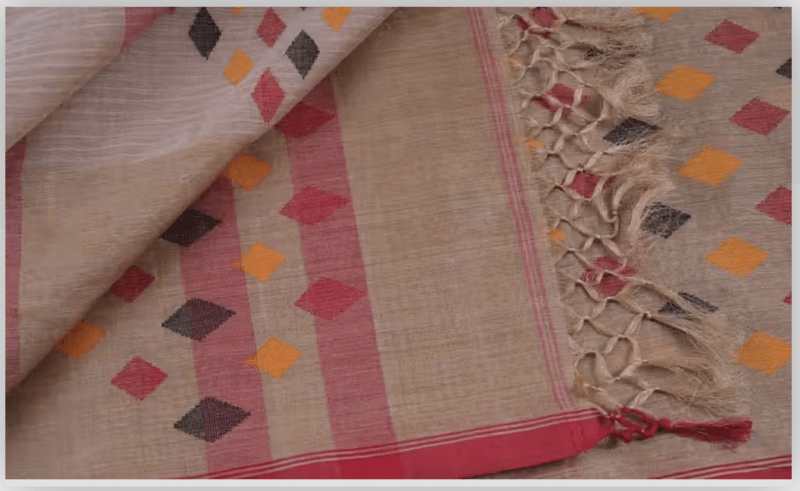Whose saree is it, anyway?
Relevance - GS Paper III
Why in News?
The Tangail saree, a handicraft, has been debated on social media regarding its geographical indication (GI) status and origin in India.
Geographical Indication (GI):
- The 1994 WTO TRIPS Agreement defines a GI as an indication that ascribes to a specific quality, reputation, or other product feature that is fundamentally attributable to its geographical origin within the territory of a WTO member or a regional locality within that territory.
- A GI is customarily applied to industrial products, handicrafts, agricultural products, consumables, and wine and spirit beverages.
Ambiguity regarding origin of Tangail saree:
- The Tangail saree falls under the definition described above, as it is a handicraft.
- The etymology of the Tangail saree indicates that it originated from an area named Tangail in West Bengal, India.
- An alternative theory suggests that most of the Tangail saree weavers relocated to West Bengal, India, following the Partition, where they persisted in producing this customary artistic creation.
- Hence, a major dispute has arisen between India and Bangladesh over the ownership of the Geographical Indication (GI) tag for the Tangail saree.
Concern for India:
- With respect to the assertion made by emigrant West Bengal Tangail saree weavers from Tangail, Bangladesh, the fundamental criterion that the product bearing the GI must have its origin in the territory of a member or a regional locality within that territory remains unsatisfied.
- It indicates that unless it can be proven that a homonymous location with the same name exists in West Bengal, India, the Tangail saree, in order to qualify as a GI product, must originate from Tangail, Bangladesh.
- In essence, a robust correlation must exist between the geographical origin of Tangail and the product Tangail saree.
- This correlation may be established through human intervention, natural occurrences, reputation, or a combination of all.
Potential legal actions:
- The interested party from Bangladesh may petition the Indian GI registry and, if required, the Appellate Board to cancel the Tangail saree’s registration. If the stakeholder continues to hold the opinion that the dispute pertains to a breach of trade regulations, Bangladesh, representing the stakeholder, may consider resorting to the WTO’s dispute settlement body.
- In the event that it is established that a geographical area bearing the identical name, Tangail, is situated in West Bengal, India, the Tangail saree will transform into a matter of international concern.
Geneva Act of the Lisbon Agreement:
- It delineates the procedure for joint application in the case of a transboundary geographical area in such circumstances.
- It stipulates that if a geographical area of origin comprises a transborder region, the neighbouring Contracting Parties may apply jointly through a commonly designated Competent Authority in accordance with their agreement.
- The act thus paves the way for unified registration of the transborder GI.
- However, neither Bangladesh nor India are signatories to the Lisbon Agreement, making it difficult to resolve the dispute.
Way forward - Homonymous Geographical Indications (GIs):
- Homonymous GIs share a similar nomenclature in terms of spelling and pronunciation; they may still meet the criteria for independent protection.
- The principles of homonymous geographical indications (GIs) are acknowledged under the legal systems of both India and Bangladesh.
- At the domestic level, distinct and autonomous registration may be possible under the names Bangladeshi Tangail saree and Indian Tangail saree if a homonymous location bearing the same name, Tangail, exists in West Bengal, India.
- The homonymous GI registration system is protracted, expensive, and cumbersome, potentially rendering the GI product of Tangail saree semi-generic in other nations and potentially revoking protection in those specific countries.
- It is exceedingly complex due to the possibility that identical qualities, reputations, and other attributes of the product are not present in both GIs.
- This usage could potentially lead to consumer confusion and unjust competition within the market.
Conclusion:
Although it is possible to protect the Tangail saree using a geographical indication (GI) tag and associate it with India through the system of Homonymous Geographical Indications. The process can be complex and contentious. The debate over its geographical origin, as well as the complexities of homonymous GIs, requires careful consideration and legal resolution.
|
Beyond Editorial: Tangail Saree:  Significance of GI Tags:
Organisations that approve and regulate GI Tag:
Benefits of GI Tags:
|
Prelims PYQ
Q. Which of the following has/have been accorded ‘Geographical Indication’ status? (UPSC 2015)
1) Banaras Brocades and Sarees
2) Rajasthani Daal-Bati-Churma
3) Tirupathi Laddu
Select the correct answer using the codes given below:
(a) 1 only
(b) 2 and 3 only
(c) 1 only 3 only
(d) 1, 2 and 3
Q. India enacted The Geographical Indications of Goods (Registration and Protection) Act, 1999 in order to comply with the obligations to (UPSC 2018)
(a) ILO
(b) IMF
(c) UNCTAD
(d) WTO
Mains PYQ
Q. How is the Government of India protecting traditional knowledge of medicine from patenting by pharmaceutical companies? (UPSC 2019)


